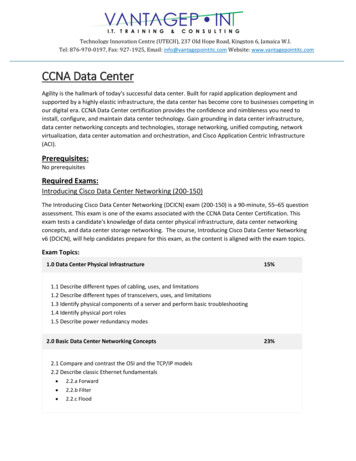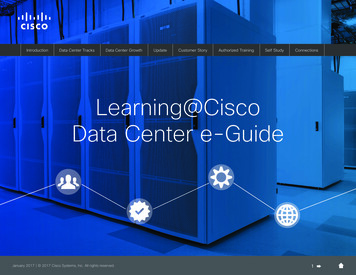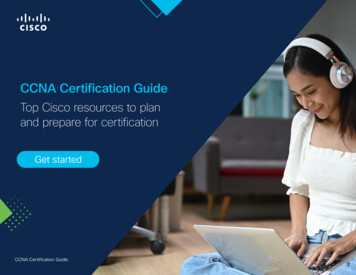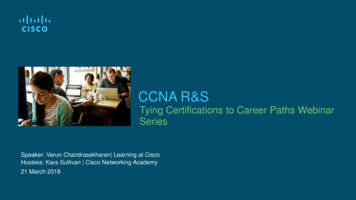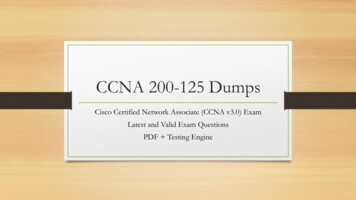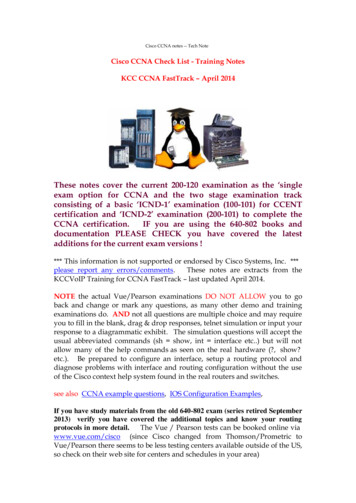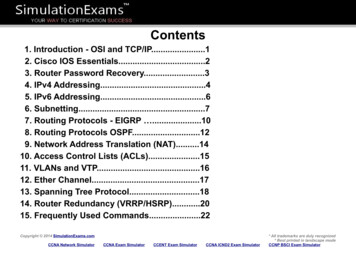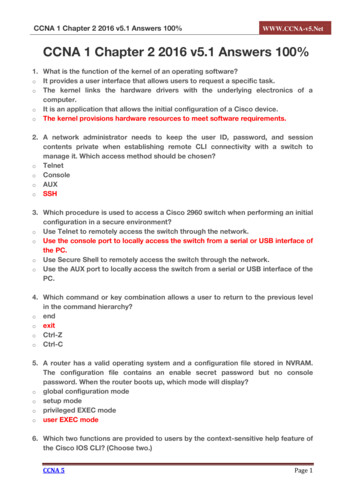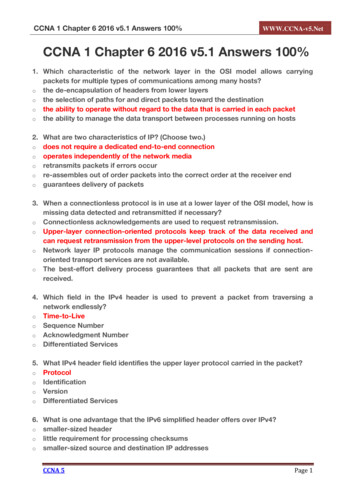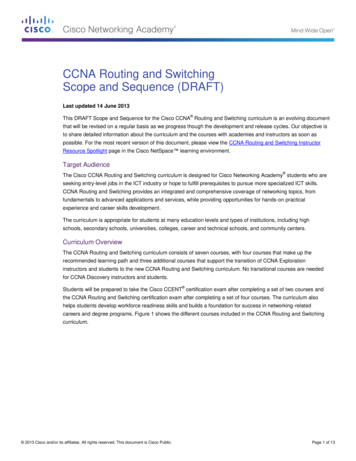
Transcription
Exclusive Offer – 40% OFFCisco PressVideo Trainingciscopress.com/videoUse coupon code CPVIDEO40 during checkout.Video Instruction from Technology ExpertsAdvance Your SkillsTrain AnywhereLearnGet star ted with fundamentals,become an expert, or get certified.Train anywhere, at yourown pace, on any device.Learn from trusted authortrainers published by Cisco Press.Try Our Popular Video Training for FREE!ciscopress.com/videoExplore hundreds of FREE video lessons from our growing library of Complete VideoCourses, LiveLessons, networking talks, and workshops.ciscopress.com/video
CCNADataCenterDCICT 200-155Official Cert GuideNAVAID SHAMSEE, CCIE No. 12625DAVID KLEBANOV, CCIE No. 13791HESHAM FAYED, CCIE No. 9303AHMED AFROSEOZDEN KARAKOK, CCIE No. 6331Cisco Press800 East 96th StreetIndianapolis, IN 46240
iiCCNA Data Center DCICT 200-155 Official Cert GuideCCNA Data CenterDCICT 200-155 Official Cert GuideNavaid Shamsee, CCIE No. 12625David Klebanov, CCIE No. 13791Hesham Fayed, CCIE No. 9303Ahmed AfroseOzden Karakok, CCIE No. 6331Copyright 2017 Pearson Education, Inc.Published by:Cisco Press800 East 96th StreetIndianapolis, IN 46240 USAAll rights reserved. No part of this book may be reproduced or transmitted in any form or by any means,electronic or mechanical, including photocopying, recording, or by any information storage and retrievalsystem, without written permission from the publisher, except for the inclusion of brief quotations in areview.Printed in the United States of AmericaFirst Printing December 2016Library of Congress Control Number: 2016949728ISBN-13: 978-1-58720-591-0ISBN-10: 1-58720-591-2Warning and DisclaimerThis book is designed to provide information about the 200-155 DCICT exam for CCNA Data Centercertification. Every effort has been made to make this book as complete and as accurate as possible, butno warranty or fitness is implied.The information is provided on an “as is” basis. The authors, Cisco Press, and Cisco Systems, Inc. shallhave neither liability nor responsibility to any person or entity with respect to any loss or damages arising from the information contained in this book.The opinions expressed in this book belong to the authors and are not necessarily those of CiscoSystems, Inc.Trademark AcknowledgmentsAll terms mentioned in this book that are known to be trademarks or service marks have been appropriately capitalized. Cisco Press or Cisco Systems, Inc., cannot attest to the accuracy of this information.Use of a term in this book should not be regarded as affecting the validity of any trademark or servicemark.
iiiSpecial SalesFor information about buying this title in bulk quantities, or for special sales opportunities (which mayinclude electronic versions; custom cover designs; and content particular to your business, traininggoals, marketing focus, or branding interests), please contact our corporate sales department atcorpsales@pearsoned.com or (800) 382-3419.For government sales inquiries, please contact governmentsales@pearsoned.com.For questions about sales outside the U.S., please contact intlcs@pearson.com.Feedback InformationAt Cisco Press, our goal is to create in-depth technical books of the highest quality and value. Each bookis crafted with care and precision, undergoing rigorous development that involves the unique expertiseof members from the professional technical community.Readers’ feedback is a natural continuation of this process. If you have any comments regarding how wecould improve the quality of this book, or otherwise alter it to better suit your needs, you can contact usthrough e-mail at feedback@ciscopress.com. Please make sure to include the book title and ISBN in yourmessage.We greatly appreciate your assistance.Editor-in-Chief: Mark TaubCopy Editor: Gill Editorial ServicesProduct Line Manager: Brett BartowTechnical Editor: David BurnsBusiness Operation Manager, Cisco Press: Ronald FliggeEditorial Assistant: Vanessa EvansExecutive Editor: Mary Beth RayDesigner: Chuti PrasertsithManaging Editor: Sandra SchroederComposition: Tricia BronkellaDevelopment Editor: Ellie BruIndexer: Ken JohnsonProject Editor: Mandie FrankProofreader: Debbie Williams
ivCCNA Data Center DCICT 200-155 Official Cert GuideAbout the AuthorsNavaid Shamsee, CCIE No.12625, is a senior solutions architect in the Cisco Servicesorganization. He holds a master’s degree in telecommunication and a bachelor’s degreein electrical engineering. He is also a triple CCIE in routing and switching, serviceprovider, and data center technologies. Navaid has extensive experience in designing,implementing and securing many large-scale enterprise and service provider data centers.In Cisco, Navaid is focused on the security of data center, cloud, and software-definednetworking technologies. You can reach Navaid on Twitter: @NavaidShamsee.David Klebanov, CCIE No.13791 (Routing and Switching), is leading TechnicalMarketing organization at Viptela, the Software Defined Wide Area Network(SD-WAN) company. David has more than 15 years of diverse industry experiencearchitecting and deploying complex network environments. In his work, David setsstrategic direction for industry-leading network platforms, which transform the world ofwide area communications for enterprises and service providers alike. David also takesgreat pride in speaking at industry events, releasing publications, and working on patents.You can reach David on Twitter: @DavidKlebanov.Hesham Fayed, CCIE No.9303 (Routing and Switching/Data Center), is a consultingsystems engineer for data center and virtualization based in California. Hesham hasbeen with Cisco for more than 11 years and has 19 years of experience in the computerindustry, working with service providers and large enterprises. His main focus is workingwith customers in the western region of the United States to address their challenges bydoing end-to-end data center architectures.Ahmed Afrose is a solutions architect at Cisco Cloud and Networking Services (C&NS)Innovation and Delivery team. He is responsible for providing architectural designguidance and leading complex multitech service deliveries. Furthermore, he is involvedin demonstrating the Cisco value propositions in data center analytics, applicationautomation, software-defined data centers, and Cisco Unified Computing System (UCS).Ahmed has a bachelor’s degree in information systems. He started his career with SunMicrosystem–based technologies and has 17 years of diverse experience in the industry.He’s been working for Cisco Systems for 7 years and was directly responsible forestablishing Cisco UCS Advanced Services delivery capabilities while evangelizing theproduct in the EMEA region. You can reach Ahmed on Twitter: @ahmedafrose.Ozden Karakok, CCIE No. 6331, is a technical leader from the data center productsand technologies team in the Technical Assistant Center (TAC). She has been with CiscoSystems for 17 years and specializes in storage area and data center networks. Prior tojoining Cisco, Ozden spent five years working for a number of Cisco’s large customers invarious telecommunication roles. She is a Cisco Certified Internetwork Expert in routingand switching, SNA/IP, and storage. A frequent speaker at Cisco and data center events,she serves as a member of the patent committee at Cisco Services. Ozden holds a degreein computer engineering from Istanbul Bogazici University. Currently, she is focused onApplication Centric Infrastructure (ACI) and software-defined storage (SDS). You canreach Ozden on Twitter: @okarakok.
vAbout the Technical ReviewersDavid Burns has in-depth knowledge of routing and switching technologies, networksecurity, data center, and mobility. Dave is currently the Vice President of Engineering& Architecture for QTS DataCenters where he is focused on driving strategy andexecution for connectivity, infrastructure, security, and data center and cloud servicesbeing delivered to QTS customers and partners. Prior to joining QTS, Dave led various Engineering & Architecture teams for both in the U.S. and internationally-focusedon Service Providers and Enterprise IT, covering the spectrum of technologies rangingfrom security, network, data center, cloud, and connectivity. Dave holds various sales,industry, and Cisco technical certifications, including CISSP, CCNP Security (formerlyCCSP), CCDP, and multiple associate-level certifications. Dave is also a published authorwith Cisco Press and active technical reviewer for multiple titles. Dave has a Masters inBusiness Administration and a Bachelor of Science in Telecommunications EngineeringTechnology.
viCCNA Data Center DCICT 200-155 Official Cert GuideDedicationsNavaid Shamsee: To my parents for their guidance and prayers. To my wife, Hareem,for her love and support, and to my children, Ahsan, Rida, and Maria.David Klebanov: This book is dedicated to my gorgeous wife, Tanya, and to our twowonderful daughters, Lia and Maya. I wanted you to know how grateful I am to haveyou in my life, and how your love and support inspire me each and every day. Tanya,your journey to become OTR/L is an inspiration to anyone pursuing personal dreamsand a true testament that if you put your mind to it, you can accomplish anything! Youare my pride, and I applaud you for your success. Lia, as you become a young adult,keep dreaming big, and remember that life is like a box of chocolates—you never knowwhat you are going to get. Let your talent and perseverance pave the way. Maya, youmay still be young, but you have a big heart. Thank you for filling our house with joyand laughter.This book is also dedicated to all of you who have chosen the path of technology.Together we can make this world a better place.Hesham Fayed: This book is dedicated to my lovely wife, Eman, and my beautiful children, Ali, Laila, Hamza, Fayrouz, and Farouk. Without your support and encouragement,I would never have been able to finish this book. I can’t forget to acknowledge my parents; your guidance, education, and encouragement to strive to be better is what helpedin my journey.Ahmed Afrose: I dedicate this book to my parents, Hilal and Faiziya. Without them,none of this would have been possible. I also dedicate this to those people who aredeeply curious and advocate self-advancement.Ozden Karakok: To my loving husband, Tom, for his endless support, encouragement,and love. Merci beaucoup, Askim.To Remi and Mira, for being the most incredible miracles of my life and being mynumber-one source of happiness.To my wonderful parents, who supported me in every chapter of my life and are aninspiration for life.To my awesome sisters, Gulden and Cigdem, for their unconditional support and lovingme just the way I am.To the memory of Steve Ritchie, for being the best mentor ever and passionatetechnology lover.
viiAcknowledgmentsFirst and foremost, I would like to say thank you to my wife Hareem for her unconditional support throughout my career and writing this book.To my co-authors, Afrose, David, Hesham, and Ozden: It is my pleasure and honorworking with you again on the second edition of this book. Without your support, thisbook would not have been possible.I would also like to say thank you to David Burns for reviewing this book and providingus feedback. His input was very valuable and it helped us improve the quality of content.A big thank-you to the entire Cisco Press team for all their support in getting this bookpublished. Special thanks to Mary Beth and Ellie for keeping us on track and guiding usin the journey of writing this book.—Navaid ShamseeMy deepest gratitude goes to all the people who have shared my journey over the yearsand who have inspired me to always strive for more. I would also like to thank my fellowauthors for the wonderful team spirit and the entire Cisco Press team for ensuring oursuccess.—David KlebanovI’d like to thank my co-authors, Navaid, Afrose, Ozden, and David, for working as ateam to complete the second edition of this book. Mary Beth and Ellie, thank you bothfor your patience and support through my second publication. It has been an honorworking with you both, and I have learned a lot during this process.I want to thank my family for their support and patience while I was working on thisbook.—Hesham FayedNavaid Shamsee has been a good friend and colleague. I am thankful to him for this awesome opportunity. He has helped me achieve a milestone in my career by offering methe opportunity to be associated with this publication and the world-renowned CiscoPress team.I’m humbled by this experienced and talented team of co-authors: Navaid, David,Hesham, and Ozden. It was a pleasure working with a team of like-minded professionals.I am also thankful to all our professional editors, especially Mary Beth Ray and Ellie Bru,for their patience and guidance every step of the way. A big thank-you to all the folksinvolved in production, publishing, and bringing this book to the shelves.To our technical reviewer, David Burns, for his keen attention to detail; it helped gaugedepth and consistency and improved the overall quality of this certification guide.—Ahmed Afrose
viiiCCNA Data Center DCICT 200-155 Official Cert GuideThis book would never have become a reality without the help, support, and advice of agreat number of people.I would like to thank my great co-authors, Navaid, David, Afrose, and Hesham. Thankyou for your excellent collaboration, hard work, and priceless time. I truly enjoyedworking with each one of you on our second book. I really appreciated Navaid takingthe lead and being the glue of this diverse team. It was a great pleasure and honor working with such talented engineers. It would have been impossible to finish this book without your support.To our technical reviewer, David Burns: Thank you for providing us with your valuablefeedback, suggestions, hard work, and quick turnaround. Your excellent input helped usimprove the quality and accuracy of the content. It was a great pleasure for all of us towork with you.To Mary Beth Ray, Ellie Bru, Mandie Frank, and the Cisco Press team: A big thank-youto the entire Cisco Press team for all their support in getting this book published. Specialthanks to Mary Beth and Ellie for their endless encouragement and support.To the extended teams at Cisco: Thank you for being patient while our minds were inthe book. Thank you for believing in and supporting us on this journey. Thank you forthe innovative organization and development team at Cisco.To all extended family and friends: Thank you for your patience and endless support.—Ozden Karakok
Contents at a GlanceIntroduction xxxiiGetting Started3Part IData Center Networking Technologies9Chapter 1Data Center NetworkingChapter 2Management and Monitoring of Cisco Nexus DevicesChapter 3Unified Fabric Overview 771147Part I ReviewPart IINetwork Virtualization113Chapter 4Cisco Nexus 1000V and Virtual SwitchingChapter 5Data Center Overlay NetworksChapter 6Virtualizing Cisco Network Devices115159189Part II ReviewPart IIICisco Unified Computing229Chapter 7Cisco UCS ArchitectureChapter 8Cisco UCS ManagerChapter 9Cisco Unified Computing System Pools, Policies, Templates, and ServiceProfiles 327Chapter 10Administration, Management, and Monitoring of Cisco UCSChapter 11Server Virtualization Solutions231295403Part III ReviewPart IVApplication Centric InfrastructureChapter 12ACI ArchitectureChapter 13ACI Logical Model and Policy FrameworkChapter 14Operating ACIPart IV Review429431515475363
x CCNA Data Center DCICT 200-155 Official Cert GuidePart VAutomation and Orchestration563Chapter 15Cloud ComputingChapter 16UCS DirectorChapter 17Understanding and Troubleshooting UCSD Workflows565583631Part V ReviewPart VIFinal PreparationChapter 18Final PreparationAppendix AAnswers to the “Do I Know This Already?” QuizzesAppendix BMemory Tables 697Appendix CMemory Tables Answer KeyGlossaryIndex721752On the Companion Website:Appendix DStudy Planner657659709679
xiContentsIntroductionxxxiiGetting Started3A Brief Perspective on the CCNA Data Center Certification Exam3Suggestions for How to Approach Your Study with This Book 3This Book Is Compiled from 17 Short Read-and-Review SessionsPractice, Practice, Practice—Did I Mention: Practice? 4In Each Part of the Book You Will Hit a New MilestoneUse the Final Preparation Chapter to Refine SkillsSet Goals and Track Your Progress6Other Small Tasks Before Getting StartedPart IData Center Networking TechnologiesChapter 1Data Center Networking 11“Do I Know This Already?” QuizFoundation TopicsPort Channel79111515What Is Port Channel?15Benefits of Using Port Channels15Port Channel Compatibility RequirementsLink Aggregation Control Protocol 16Port Channel Modes17Configuring Port Channel18Port Channel Load Balancing19Verifying Port Channel ConfigurationVirtual Port Channel20What Is Virtual Port Channel? 20Benefits of Using vPCComponents of vPC2222vPC Data Plane Operation24vPC Control Plane OperationvPC Limitations27Configuration Steps of vPCVerification of vPCFabricPath262929Spanning Tree Protocol 29What Is FabricPath?31271916654
xiiCCNA Data Center DCICT 200-155 Official Cert GuideBenefits of FabricPath31Components of FabricPath32FabricPath Frame Format34FabricPath Control Plane35FabricPath Data Plane37Conversational Learning38FabricPath Packet Flow Example38Unknown Unicast Packet Flow39Known Unicast Packet Flow 39Virtual Port Channel Plus40FabricPath Interaction with Spanning TreeConfiguring FabricPathVerifying FabricPathReference List41424344Exam Preparation TasksReview All Key Topics4545Complete Tables and Lists from Memory 45Define Key TermsChapter 245Management and Monitoring of Cisco Nexus Devices“Do I Know This Already?” QuizFoundation Topics4750Operational Planes of a Nexus Switch50Data Plane 50Store-and-Forward SwitchingCut-Through Switching5151Nexus 5500 Data Plane ArchitectureControl Plane5153Nexus 5500 Control Plane Architecture 54Control Plane Policing55Control Plane Analyzer57Management Plane 58Nexus Management and Monitoring FeaturesOut-of-Band ManagementConsole Port5960Connectivity Management Processor 61Management Port (mgmt0) 61In-Band Management625947
xiiiSimple Network Management ProtocolSNMP Notifications6263SNMPv3 63Remote Monitoring64RMON Alarms64RMON Events65Syslog65Embedded Event ManagerEvent Statements66Action StatementsPolicies666666Generic Online DiagnosticsSmart Call HomeNX-API6868Role-Based Access ControlUser RolesRules67707171User Role Policies72RBAC Characteristics and GuidelinesPrivilege Levels7272Reference List 73Exam Preparation TasksReview All Key Topics7474Complete Tables and Lists from Memory 74Define Key TermsChapter 374Unified Fabric Overview77“Do I Know This Already?” QuizFoundation Topics7780Challenges of Today’s Data Center NetworksCisco Unified Fabric Principles82Convergence of Network and StorageScalability and Growth88Security and Intelligence93Inter-Data Center Unified FabricFibre Channel over IP9798Overlay Transport Virtualization100Locator ID Separation Protocol 1048280
xivCCNA Data Center DCICT 200-155 Official Cert GuideReference List106Exam Preparation TasksReview All Key Topics107107Complete Tables and Lists from Memory 107Define Key Terms107Part I Review 108Part IINetwork Virtualization113Chapter 4Cisco Nexus 1000V and Virtual Switching“Do I Know This Already?” QuizFoundation Topics115116119Evolution of Virtual Switching119Before Server Virtualization119Server Virtualization with Static VMware vSwitch121Virtual Network Components 122Virtual Access Layer123Standard VMware vSwitch Overview124Standard VMware vSwitch Operations125Standard VMware vSwitch ConfigurationVMware vDS Overview127128VMware vDS Configuration129VMware vDS Enhancements 131VMware vSwitch and vDS131Cisco Nexus 1000V Virtual Networking SolutionCisco Nexus 1000V System Overview132134Cisco Nexus 1000V Salient Features and Benefits134Cisco Nexus 1000V Series Virtual Switch ArchitectureCisco Nexus 1000V Virtual Supervisory ModuleCisco Nexus 1000V Virtual Ethernet Module137137138Cisco Nexus 1000V Component Communication 140Cisco Nexus 1000V Management Communication140Cisco Nexus 1000V Port Profiles 141Types of Port Profiles in Cisco Nexus 1000V 142Cisco Nexus 1000V Administrator View and RolesCisco Nexus 1000V Verifying Initial ConfigurationCisco Nexus 1000V VSM Installation Methods142144144
xvInitial VSM Configuration Verification145Verifying VMware vCenter ConnectivityVerifying Nexus 1000V Module Status145147Cisco Nexus 1000V VEM Installation Methods148Initial VEM Status on ESX or ESXi Host 148Verifying VSM Connectivity from vCenter ServerVerifying VEM Agent Running148148Verifying VEM Uplink Interface Status 149Verifying VEM Parameters with VSM ConfigurationValidating VM Port Groups and Port Profiles150150Verifying Port Profile and Groups 152Key New Technologies Integrated with Cisco Nexus 1000VWhat Is the Difference Between VN-Link and VN-Tag?What Is VXLAN?153What Is vPath Technology? 154What Is Cisco Application Virtual Switch (AVS)?154Reference List 155Exam Preparation Tasks156Review All Key Topics156Complete Tables and Lists from Memory 156Define Key TermsChapter 5157Data Center Overlay Networks159“Do I Know This Already?” QuizFoundation Topics159162Overlay Transport Virtualization162Introduction to Overlay Transport VirtualizationOTV TerminologyOTV Control Plane164166Multicast-Enabled Transport Infrastructure166Unicast-Enabled Transport Infrastructure 167Data Plane for Unicast Traffic168Data Plane for Multicast TrafficFailure IsolationSTP Isolation170172172Unknown Unicast HandlingARP Optimization162173172153153
xviCCNA Data Center DCICT 200-155 Official Cert GuideOTV Multihoming173First Hop Redundancy Protocol Isolation174OTV Configuration Example with Multicast TransportOTV Configuration Example with Unicast TransportVirtual Extensible LAN179VXLAN TerminologyVTEP180VNID181180VXLAN Gateway TypesVXLAN BridgingVXLAN Routing174177181181181VXLAN Packet Forwarding183VXLAN VTEP Discovery and Address LearningVXLAN Data Plane Learning183184VXLAN Unicast-Only Mode 184VXLAN Using Control Plane Protocol184Network Virtualization Using Generic Routing EncapsulationReference List185Exam Preparation Tasks186Review All Key TopicsDefine Key TermsChapter 6184186186Virtualizing Cisco Network Devices“Do I Know This Already?” QuizFoundation Topics189189192Describing VDCs on the Cisco Nexus 7000 Series Switch 192VDC Deployment Scenarios194Horizontal Consolidation Scenarios 194Vertical Consolidation Scenarios 195VDCs for Service Insertion 196Understanding Different Types of VDCsInterface Allocation198VDC CPU Shares and Hardware ResourcesVDC AdministrationVDC Requirements196199199200Verifying VDCs on the Cisco Nexus 7000 Series SwitchDescribing Layer 3 Virtualization Within VDCs204201
xviiDescribe the Benefits and Perform Simple Troubleshooting of VDCSTP 207Verifying STP Operation209Describing Network Interface VirtualizationCisco Nexus 2000 FEX Terminology210210Nexus 2000 Series Fabric Extender ConnectivityVN-Tag Overview211212Cisco Nexus 2000 FEX Packet Flow213Cisco Nexus 2000 FEX Port Connectivity214Cisco Nexus 2000 FEX Configuration on the Nexus 7000 SeriesCisco Adapter FEX Technology 219Reference List 221Exam Preparation TasksReview All Key TopicsDefine Key TermsPart II Review222222222224Part IIICisco Unified ComputingChapter 7Cisco UCS Architecture229231“Do I Know This Already?” QuizFoundation Topics232235Evolution of Server Computing in a NutshellWhat Is a Socket?What Is a Core?235236236What Is Hyperthreading?237Understanding Server Processor Numbering237Value of Cisco UCS in the Data Center 238One Unified SystemUnified Fabric239240Unified Management and OperationsCisco UCS Stateless Computing240241Intelligent Automation, Cloud-Ready Infrastructure242Describing the Cisco UCS Product Family 243Cisco UCS Computer Hardware NamingCisco UCS Fabric InterconnectsWhat Is a Unified Port?243244247What Are QSA Modules and Breakout Cables?247216
xviiiCCNA Data Center DCICT 200-155 Official Cert GuideCisco UCS Fabric Interconnect—Expansion ModulesCisco UCS 5108 Blade Server Chassis247248Cisco UCS 5108 Blade Server Chassis—Power Supply and RedundancyModes 248Cisco UCS M4308 Chassis249Cisco UCS I/O Modules (FEX)250Cisco UCS B-Series Blade Servers251Cisco UCS B-Series Best Practices for Populating DRAM253Cisco Adapters (Mezzanine Cards) for UCS B-Series Blade ServersCisco Converged Network Adapters (CNA)Cisco Virtual Interface Cards254255Cisco UCS VIC 1340/1380256Cisco UCS Port Expander257What Is Cisco Adapter FEX? 257What Is Cisco Virtual Machine-Fabric Extender?257Cisco UCS Storage Accelerator Adapters 258Cisco UCS C-Series Rackmount Servers258Cisco UCS C-Series Dense Storage Rack Server261Cisco UCS C-Series Best Practices for Populating DRAMCisco Adapters for UCS C-Series Rackmount ServersCisco UCS C-Series RAID Adapter Options261262262Cisco UCS C-Series Virtual Interface Cards and OEM CNAAdapters 265Cisco UCS VIC 1387 mLOM266What Is SR-IOV (Single Root-IO Virtualization)?Cisco UCS C-Series Network Interface CardCisco UCS C-Series Host Bus Adapter267268What Is N Port ID Virtualization (NPIV)? 269Cisco UCS Storage Accelerator Adapters 270Cisco UCS E-Series ServersCisco UCS Mini271272Cisco UCS M-Series Servers272Cisco UCS Software 274Cisco UCS ManagerCisco UCS Central274274Cisco UCS StorMagic SvSANCisco UCS DirectorCisco IMC Supervisor274275274266254
xixSystem Menu276Policies Menu276Administration Menu276Cisco UCS Platform Emulator 277Cisco goUCS Automation Tool 277Cisco UCS Connectivity Architecture277Cisco UCS 5108 Chassis to Fabric Interconnect PhysicalConnectivity 277Cisco UCS C-Series Rackmount Server Physical Connectivity 278Cisco UCS 6200 Fabric Interconnect to LAN, SAN Connectivity280Cisco UCS Fabric Interconnect Switching Modes 281Ethernet Switching Mode281Fibre Channel Switching Mode 282Cisco UCS I/O Module and Fabric Interconnect ConnectivityCisco UCS I/O Module Architecture283285Fabric and Adapter Port Channel Architecture287Cisco Integrated Management Controller Architecture287Reference List 289Exam Preparation Tasks290Review All Key Topics290Complete Tables and Lists from Memory 292Define Key TermsChapter 8292Cisco UCS Manager295“Do I Know This Already?” QuizFoundation Topics296299Cabling a Cisco UCS Fabric Interconnect HA ClusterCisco UCS Fabric Interconnect HA Architecture299299Cisco UCS Fabric Interconnect Cluster ConnectivityInitial Setup Script for Primary Fabric Interconnect300302Initial Setup Script for Subordinate Secondary Fabric InterconnectVerify Cisco UCS Fabric Interconnect Cluster Setup303Changing Cluster Addressing via Command-Line InterfaceCommand Modes303305305Changing Cluster IP Addresses via Command-Line Interface306Changing Static IP Addresses via Command-Line Interface 306Cisco UCS Manager Operations307Cisco UCS Manager FunctionsCisco UCS Manager GUI Layout307310
xxCCNA Data Center DCICT 200-155 Official Cert GuideCisco UCS Manager: Navigation Pane—Tabs313Equipment Tab 313Servers Tab 314LAN Tab314SAN Tab315VM Tab 315Admin Tab317Storage Tab317Basic Port Roles in the Cisco UCS Fabric Interconnects318Cisco UCS Manager Hardware Discovery 319Verifying Device Discovery in Cisco UCS ManagerReference ListExam Preparation Tasks324Review All Key TopicsDefine Key TermsChapter 9321323324325Cisco Unified Computing System Pools, Policies, Templates, andService Profiles 327“Do I Know This Already?” QuizFoundation Topics327331Cisco UCS Service Profiles331Cisco UCS Hardware Abstraction and Stateless ComputingContents of a Cisco UCS Service Profile333Other Benefits of Cisco UCS Service ProfilesEase of Incremental Deployments331335335Plan and Preconfigure Cisco UCS Solutions335Ease of Server Replacement 336Right-Sized Server DeploymentsCisco UCS Templates336336Organizational Awareness with Service Profile TemplatesCisco UCS Service Profile TemplatesCisco UCS vNIC Templates339Cisco UCS vHBA Templates339Cisco UCS Logical Resource PoolsUUID Identity Pools341MAC Address Identity PoolsWWN Address Identity PoolsWWNN Pools343WWPN Pools344340342343338337
xxiCisco UCS Physical Resource PoolsServer Pools345345Cisco UCS Server Qualification and Pool PoliciesServer Auto-Configuration Policies345346Creation of Policies for Cisco UCS Service Profiles and Service ProfileTemplates 347Frequently Used Policies Explained347Equipment Tab—Global Policies 347BIOS PolicyBoot Policy348348Local Disk Configuration Policy 349Maintenance Policy 350Scrub Policy351Host Firmware Packages 351Adapter Policy352Cisco UCS Chassis and Blade Power CappingWhat Is Power Capping?353353Cisco UCS Power Capping Strategies 353Utilizing Cisco UCS Service Profile Templates355Creating Cisco UCS Service Profile Templates355Modifying a Cisco UCS Service Profile Template356Utilizing Cisco UCS Service Profile Templates for DifferentWorkloads 357Creating Service Profiles from Templates357Reference List 359Exam Preparation TasksReview All Key Topics360360Complete Tables and Lists from Memory 361Define Key TermsChapter 10361Administration, Management, and Monitoring of Cisco UCS“Do I Know This Already?” QuizFoundation Topics363367Cisco UCS AdministrationOrganization and Locales367367Role-Based Access Control 369363
xxiiCCNA Data Center DCICT 200-155 Official Cert GuideAuthentication MethodsLDAP Providers370370LDAP Provider Groups370Domain, Realm, and Default Authentication Settings 371Communication Management372UCS Firmware, Backup, and License ManagementFirmware Terminology 373Firmware Definitions374Firmware Update Guidelines375Host Firmware Packages 375Cross-Version Firmware SupportFirmware Auto InstallUCS Backups376376377Backup Automation378License Management379Cisco UCS Management380Operational Planes380In-Band Versus Out-of-Band ManagementRemote AccessibilityDirect KVM Access381382382Advanced UCS Management383Cisco UCS Manager XML API383goUCS Automation Toolkit 384Using the Python SDK386Multi-UCS ManagementCisco UCS Monitoring387387C
Cisco Press 800 East 96th Street Indianapolis, IN 46240 CCNA Data Center DCICT 200-155 Official Cert Guide NAVAID SHAMSEE, CCIE No. 12625 DAVID KLEBANOV
